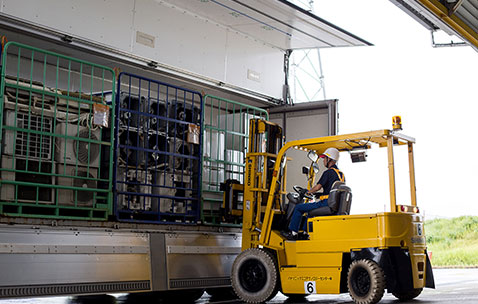Reducing CO₂ emissions
Less CO2 through more efficiency and holistic energy solutions
In general, CO2 emissions increase along with an increased energy consumption. So the most obvious step and most important lever is to reduce energy consumption and increase energy efficiency in the production process. Continuously, Panasonic investigates any opportunities for further improvement and reduction of energy consumptions with all factories individually – based on their consumption data.
Energy-saving production methods
Panasonic has developed manufacturing methods with minimal energy consumption. in Wuxi, automation and robots increase productivity by 10 percent with the same energy consumption.
Use of energy management systems
Panasonic is also continuously expanding the use of energy management systems such as FEMS (Factory Energy Management System) in its factories. By using artificial intelligence for energy management, Panasonic was able to reduce energy consumption by 14 percent at its most recent zero-CO2 factory in Wuxi, China.
Use of modern technologies
Panasonic saves 330 tons of CO2 per year in its pilot factories by using inverters for dust collectors, pumps and exhaust fans. Additional 330 tons will be saved by installing inverse compressors and vacuum pumps. Since 2019, Panasonic has successfully replaced fluorescent tubes, halogen metal halide lamps, and downlight lamps with more efficient LED lights at 13,725 Panasonic sites, including its factories.
Renewable energy

To supply energy to its fuel cell factory in Kusatsu, Shiga Prefecture, Japan, Panasonic uses a combination of photovoltaic panels, battery storage and hydrogen fuel cells, to create a multi-stage and flexible energy system.
In order to reduce CO2 emission in the manufacturing process, the use of renewable energy plays a pivotal role. Therefore Panasonic promotes the procurement and use of electricity that is derived from renewable sources – “green electricity”(e.g. wind, solar and hydro power). This has been implemented at various factories globally and is in the process of being further expanded as much as possible.
In addition to the procurement of electricity from renewable sources, Panasonic is implementing and will further accelerate the generation of renewable electricity onsite, e.g. using photovoltaic systems in the context of zero CO2 emission factories.
Energy storage to balance volatility
Where does a factory get its energy from when it’s dark and no PV energy is generated?
This is where two important complementary technologies come into play: fuel and battery storage. As one of the world’s largest producers of lithium-ion batteries and energy storage systems, Panasonic is investigating how green electricity can be made independent of the weather and stored efficiently in its pilot factories. Batteries are suitable as short-term and intermediate storage for green electricity.
Fuel cells and green hydrogen are a suitable supplement. From it, environmentally friendly and pollutant-free energy can be created with fuel cells through the process of electrolysis. The only emissions or by-products released using such a process are oxygen and water. Panasonic has developed fuel cells that work with such pure, green hydrogen.
To develop innovative ways for its plants to create more energy than it uses, Panasonic created a model factory in Japan at the headquarters of its Appliances business (incl. CE and air con). The use of hydrogen to power the factory and in particular also the fleet (fork lifts etc) onsite is one of the major test aspects at this factory. For more information on the use of hydrogen as energy source at Panasonic’s Kusatsu RE100 factory, please read more here.

Hydrogen farm at the Panasonic factory site in Kusatsu, Shiga Prefecture, Japan
Related sustainable manufacturing topics
The avoidance of pollutants in the production process
With the aim of protecting the environment and its customers, Panasonic has developed and implemented its own management system for chemical substances in products, with chemical substances managed throughout the global supply chain, production and use of products.
For more information, please contact
Panasonic Europe B.V.
Corporate Communications



